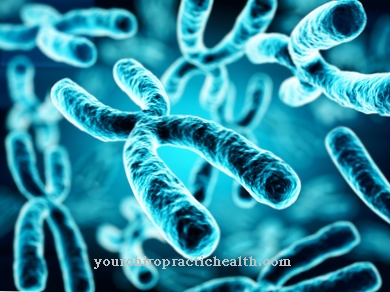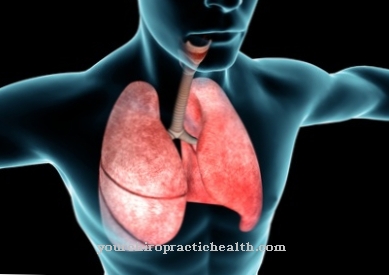The enchondral ossification is the indirect ossification from the inside, which takes place via the intermediate stage of the cartilage. Connective tissue and mesenchyme are the basic materials for ossification. If the structure of the connective tissue is changed, this can cause severe ossification disorders.
What is enchondral ossification?

The ossification or Osteogenesis is the formation of bone tissue. It takes place in the human organism on the one hand during growth and on the other hand for regeneration after bone fractures.
New bone either forms directly from connective tissue or is formed via an intermediate stage. Cartilage elements usually act as an intermediate stage. The chondral ossification is the indirect process that is realized through intermediate stages. The end product is also known as the replacement bone.
Chondral ossification occurs either internally or externally. If the ossification occurs from the outside, it is called perichondral osteogenesis. Enchondral ossification, on the other hand, is ossification from within. The opposite of the chondral types of ossification is desmal ossification, in which bones arise directly from the connective tissue. A third type of formation of bone tissue is appositional ossification, which is the thickness of the bone. With this type of growth, bone tissue attaches to existing bone material. Perichondral ossification is, for example, a type of appositional ossification.
Function & task
Together with the gelatinous connective tissue, the so-called mesenchyme makes up the embryonic connective tissue. The mesenchyme is the basic material for the development of loose and tight reticular connective tissue. It is involved in the development of the smooth muscles and the heart muscle, contributes to the kidneys and the adrenal cortex and is required for the formation of the blood-forming system including all blood and lymph vessels. Apart from that, bones and cartilage are formed from the mesenchyme.
In chondral ossification, the material is transformed into cartilaginous elements, which are known as the primordial skeleton. Because of this intermediate stage, the process is also called indirect ossification. The resulting bones are the replacement bones.
The ossification from the outside is the perichondral ossification. During this process, the osteoblasts split off from the skin of the cartilage (perichondrium) and form a ring around the model of the cartilage. In this way a bone cuff is formed which contributes to the growth in thickness of the bone and is therefore counted as part of appositional osteogenesis.
The enchondral ossification must be distinguished from this type of bone growth in that the ossification is carried out from within in this process. During this process, blood vessels grow piece by piece into the tissue of the cartilage. Accompanied by the blood vessels, mesenchymal cells also migrate into the cartilage. Thereupon a differentiation of the cells takes place. Some of the migrated mesenchymal cells become chondroclasts. Others mature into osteoblasts. Chondroclasts break down bones. Osteoblasts are responsible for building bones.
In the epiphyseal plates, length growth occurs due to the permanent build-up and breakdown processes, which is also known as interstitial growth. An interior space is created inside the bone. This inner space is called the primary marrow and is involved in the formation of the actual bone marrow.
In both enchondral and perichondral ossification, the osteoblasts give off the so-called osteoid as the basic substance. Under the influence of the osteoblastic ferments, calcium salts are deposited on the bones, whereupon the osteoblasts differentiate into osteocytes. The starting points of every ossification are called ossification centers or bone nuclei.
Illnesses & ailments
The most well-known clinical pictures in connection with ossification are the so-called ossification disorders, with which orthopedics are primarily concerned. One of the most famous diseases in this group is Osgood-Schlatter's disease. In this disease, free bone fragments come off as part of the disturbed ossification. Many athletes are affected. The cause lies in a lack of balance between resilience and the actual load on the cartilage. Heavy loads on the knee joints are particularly often associated with the phenomenon. The apophysis of the tibia is overloaded by mechanical stress in the context of Osgood-Schlatter's disease, so that all types of ossification are disturbed. The insertion site of the fibrous tendon parts is close to the ossification front. At this point, the tibial tuberosity is thickened. Because of the osteochondronecrotic processes, smaller areas of the affected region detach themselves from the tissue in the form of free ossicles.
Glass bone disease is also related to impaired osteogenesis. Those affected suffer from abnormally light and easily brittle bones, as their type one collagens show genetic changes. These collagens are a major component of connective tissue. Since both the enchondral and the perichondral ossification make use of connective tissue, 90 percent of the bone matrix in patients with this hereditary disease is changed. The cause is presumably a point mutation on chromosomes 7 and 17. Key symptoms include skeletal deformities, bending of the spine and overstretching joints.
Sometimes ossification takes place not only in cartilage, but also in soft tissue. This is also a pathological phenomenon that is most often associated with what is known as myositis. Muscle ossification with calcium deposits is one of the main symptoms of this phenomenon. An autoimmunological cause is now being considered for this disease.













.jpg)

.jpg)
.jpg)











.jpg)